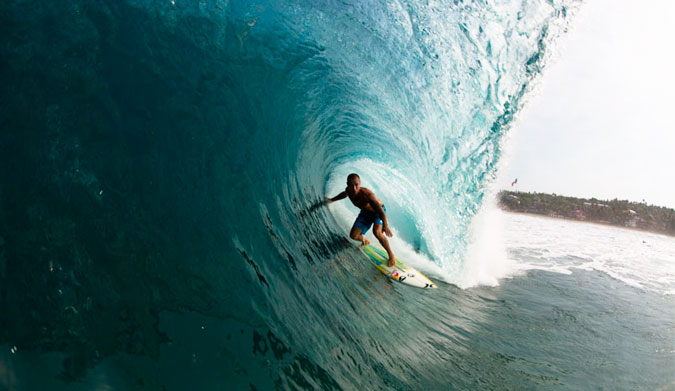
Getting this deep on a Puerto bomb takes some training. Photo: John Maher
Surfing is older than most sports. It has a much richer, deeper history, yet there’s a gap between our sport and traditional sports. Take football, for example: if little Johnny wanted to play football but didn’t put in the time working-out, most people would easily recognize that Johnny’s not going far, if he doesn’t get crushed from the start. But if he wants to surf, we tell him to make sure he’s a good swimmer (if that) and just get out there. The rest will come naturally, right? Maybe when football players were wearing leather helmets, that thought process worked. Other athletes know they need to train for their sport because it’s been drilled into them since they were little kids.
I’m a cookbook type of a guy. I like things in order with a list of what to do, start to finish. So let’s start at Step One: paddling.
In surfing, that means we start with paddling. The main muscles in paddling are the latissimus dorsi, rhomboids, deltoids, and triceps. They act together to pull our arms through the water taking us out to the line up, and once we’re there, into waves. For most of us, it’s not the most exciting part of our sport, but it’s still a crucial element. The main thing we want to focus on here is muscular endurance, which is muscle’s ability to keep up with repeated contractions for an extended period of time. Keeping that in mind, we want to train those muscles at a mild resistance with a high frequency of reps. Exercises like physioball swims with bands or light dumbbells, battle rope exercises or even renegade rows are great ways to extend our endurance and ensure longer sessions with more waves ridden. As a progression, add in strength and power by doing pull ups and medicine ball slams to get more out of every paddle.
So now that you’re out there and have stroked into a wave, we’ll move onto Step Two: the pop up.
When we get to our feet, we’re obviously using our legs. The question is, which muscles are the most important and why? I’m going to break this up into two parts: prime movers and stabilizing muscles.
The prime movers are used for larger actions, like digging a rail during a turn, or holding a line off a steep backside drop. Smaller stabilizing muscles are used to maintain balance and control during those actions. To me, the main prime movers to focus on are the soleus, quadriceps, hamstrings, hip flexor and gluteus maxims. The stabilizing muscles are the gastrocnemius, abductors and adductors of the upper leg and the gluteus medius. To get the most out of these muscles, a mix of power and strength for prime movers needs to be coupled with stability and balance in stabilizing muscles. Exercises such as plyometrics (jumping) onto or from an Indo is a great way to build power that stresses control and translates extremely well to your surfing. Squat and dead-lift variations while standing on an a single leg or Indo will build the right type of strength and stability.
Lastly– and to me, the cornerstone of surfing – is Step Three: the Core.
All maneuvers in surfing revolve around torquing our bodies in and out of rotations. Rotation is controlled by the lumbo-pelvic-hip complex. The National Academy of Sports Medicine breaks this complex of muscles into two groups: stabilization and movement. There are six muscles in the stabilization: transverse abdominus, interal obliques, lumbar multifidus, pelvic floor muscles, diaphragm and transversopnialis.
After you’re done with those, there are eight more involved in the movement: latissiums dorsi, erector spinae, illiopsas, hamstrings, hip adductors and abductors, rectus abdominis and external obliques. This a very large and complex group that should be well understood when training for surfing. Power, agility, strength and stability are all factors for this area. Movements like a single arm snatch to a windmill squat or rotational med-ball slams all on your Indo are great examples of ways to target the whole complex and improve any level of surfers abilities in the water.
I know there were some large Latin words in here, so thanks for riding this out. Being better aware of what your body is doing can only help you progress as a surfer.I hope you got a better idea of what needs to be worked and how to do it. If you still have questions or want a free PDF of pictures and descriptions of the exercise mentioned above email us at info@extremeathletics.org and we’ll be happy to help you out.
To learn more about Extreme Athletics, check out their website here.

